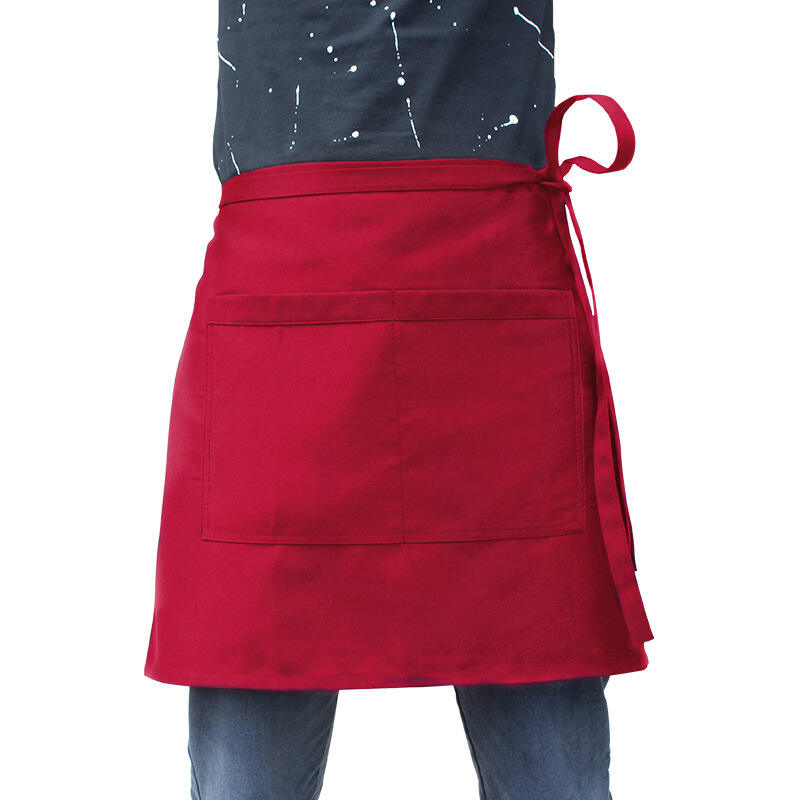The evolution of professional kitchen equipment reflects the industry's constant pursuit of efficiency, and 2025 has brought innovations that could transform how culinary teams approach their daily workflows. In fast-paced culinary environments, efficiency and functionality may be non-negotiable elements that separate successful operations from those struggling to maintain competitive standards.
The 2025-design half aprons could address critical pain points for kitchen managers and procurement teams by integrating hidden tool pockets that keep essential utensils within arm's reach throughout demanding service periods.
Unlike traditional aprons that might force staff to juggle tools or make repeated trips to storage areas, these aprons may streamline workflows in ways that could measurably impact productivity. The strategic placement of compartments could reduce movement waste, allowing chefs to focus on precision tasks without compromising speed during peak service hours when every second might count toward customer satisfaction.
Innovation in kitchen apparel reflects a deeper understanding of operational challenges that have persisted for decades. The concealed storage solutions in these aprons may resolve one of the most frequent frustrations reported in commercial kitchens: misplaced or inaccessible tools that could disrupt service flow. By embedding multiple discreet pockets in ergonomic positions, the design could ensure spatulas, thermometers, and tasting spoons remain secure yet instantly accessible.
This feature might prove particularly valuable in high-volume settings like banquet halls or institutional kitchens, where even minor delays in tool retrieval could disrupt entire service cycles. For procurement teams evaluating chef aprons, this innovation may translate directly into measurable time savings and reduced operational friction that could improve both efficiency and staff satisfaction.
While innovative features capture attention, commercial laundry cycles and constant wear may demand aprons that withstand industrial-grade use without compromising functionality. The 2025 iteration could utilize reinforced stitching at stress points and abrasion-resistant fabrics that might maintain structural integrity through repeated washes.
Cross-functional procurement committees may appreciate how the contoured waistband and adjustable neck straps accommodate diverse body types, potentially minimizing workplace injuries caused by poorly fitted uniforms.
These design choices might not only extend product lifespan but also reduce long-term replacement costs, a key consideration for hospitality groups managing multi-location inventories where consistency could be challenging to maintain.

Individual benefits naturally extend to team-wide improvements when equipment design considers collaborative workflows. These aprons could contribute to team-wide efficiency gains in ways that might surprise managers focused solely on individual productivity metrics. Standardized tool placement across staff members may foster muscle memory during collaborative tasks, whether during line cooking or plating events where coordination becomes crucial.
The moisture-wicking fabric layer, often overlooked in generic aprons, could play a crucial role in maintaining crew comfort during extended shifts, a detail that might directly impact staff retention rates in competitive job markets. Facility managers overseeing large-scale operations may report that intuitive uniform upgrades like these correlate with fewer equipment-related errors and faster onboarding for new hires.
As team performance improves, hospitality businesses grappling with tight margins may find value in the apron's stain-resistant finish, which could preserve professional appearance across shifts without requiring chemical-heavy cleaning methods. The modular design might allow for easy replacement of specific components like straps or pockets, avoiding the need for full apron replacements that could create unnecessary expense.
This sustainability advantage may align with corporate ESG goals while addressing practical concerns. Bulk purchasing departments should note that the universal sizing system could reduce inventory complexity while accommodating seasonal staffing fluctuations common in resorts and catering services.
Looking beyond immediate cost considerations, restaurant concepts may evolve to meet post-pandemic demands for efficiency that require different approaches to traditional operations. These aprons could answer growing requests for PPE that supports rapid task-switching between stations, a capability that might become increasingly important as kitchens adapt to new service models. The antimicrobial treatment, now expected in professional food handling gear, may provide an additional layer of compliance for health inspectors whose standards continue evolving.
For procurement officers comparing vendor proposals, the apron's compatibility with standard kitchen tech, from RFID badge holders to Bluetooth temperature sensor loops, could position it as a foundational component in smart kitchen initiatives that may reshape the industry.